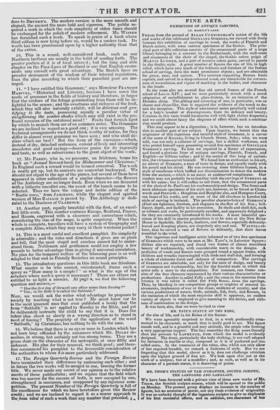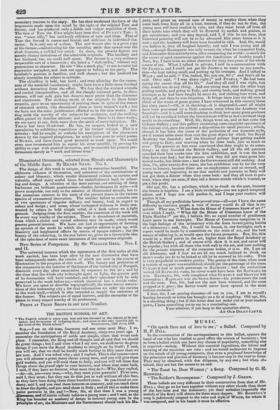MR. THOM'S STATUES OF TAM O'SHANTER, SOLVER JOHNNY, THE LANDLORD
AND LANDLADY.
WE have been favoured with a private view of these new works of Ms. Tnost, the Scottish sculptor-mason, which will be opened to the public; on Monday. The present group displays an increase in the number of figures, but no accession of power, nor any fresh evidence of originality. It was an unlucky thought of the ingenious sculptor to give us duplicates of his first successful efforts, and in addition, two characters of but secondary interest in the stgry. . He has thus weakened theforce of the impression made upon the mind by the sight of the original Tam and Souter, and has produced only a feeble and vulgar repetition of them. The face of Tam the First might have been that of Bonws's Tam ; it was " unco silly," but recklessly oblivious of care and time. That of Tam the Second is coarse and brutal, and deficient in individual cha- racter. It is only one of a class. The new Souter also is a gross copy of the former,—substituting for the mantling smile that spread over the sleek features, a well-fed low k. In shurt, the present figures are merely clumsy imitations of the admirable originals. The landlady mid her husband, too, we could well spare. The former is a very ordinary respectable sort of a housewife ; the latter a "daft carlin," without any pretensions to character. Ile sits "like a stuck pig," to use a coarse but expressive metaphor, and does not appear to belong to the party. The landlady's position is familiar, and well chosen ; but the landlord too Closely resembles the others in attitude.
The chiselling is bold, but hard ; and even allowing for the coarse- ness of the material (sandstone), might have been a little more finished without detracting from the effect. We fear that the worsted overalls and corded inexpressibles, and all the cheaply imitated parts, in these Statues, will not only gain but deserve more praise than the character and expression. The striking merit of the originals in these latter respects, gave us an opportunity of praising them in spite of the sneers of educated artists, who denounced them as mere mason's work ; but we have not the same justification afforded us in the new works. Set- ting aside the novelty of the subjects for sculpture, and the striking effect gained by familiar attitude and costume, there is in these works, we are sorry to say, little more than the merit of mere imitation. Mr. Thom has been ill-advised. He has, we suspect, looked to a sure speculation by exhibiting repetitions of his former subject. This is a mistake : had he sought to embody his conceptions of the characters drawn by the inspired ploughman, he might have gone to other poems of Buns: s, and have found good material to work upon. We would even now recommend him to repair his error speedily, by proving his ability to cope with poetical invention, and to consider his present per- formances merely as "work and labour done."



























 Previous page
Previous page